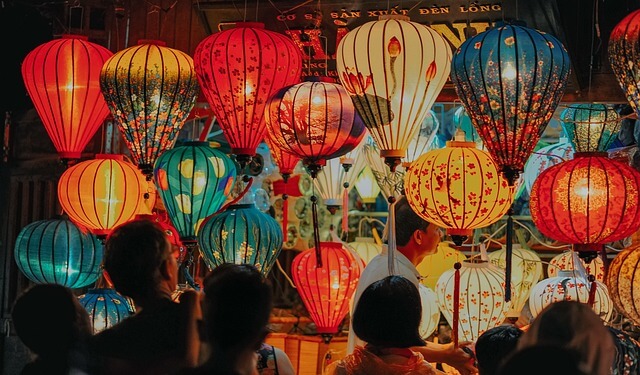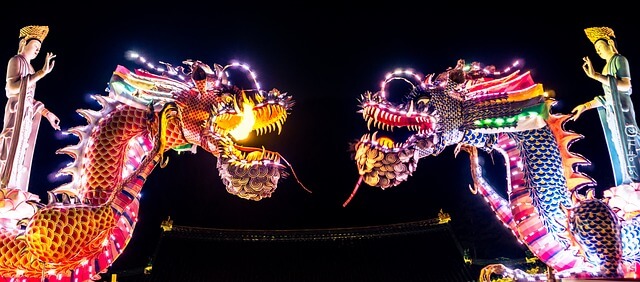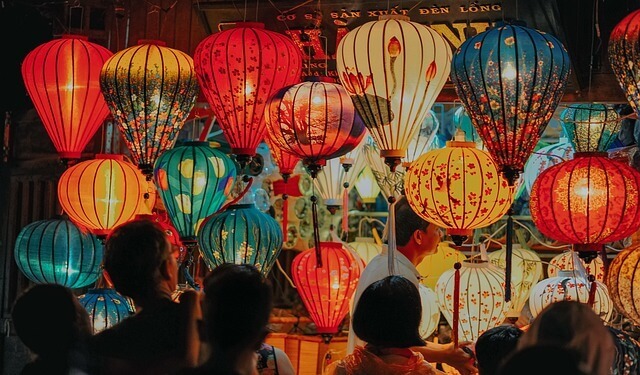
Welcome, fellow adventurers, to a journey through the heart of Asia, where ancient traditions blend seamlessly with modern-day celebrations.
In this comprehensive guide, we’ll embark on an exploration of the vibrant tapestry of Dragon Festivals that grace the continent, igniting the sky with roaring flames and infusing the air with cultural fervor.
Whether you’re a seasoned traveler seeking your next adventure or a curious soul eager to learn, prepare to be enchanted by the spectacle and spirit of these extraordinary events.
Why Dragon Festivals Matter:
Dragon Festivals hold a special place in the hearts of millions across Asia and beyond. Here’s why these celebrations matter more than ever:
Experience the heartbeat of Asia: Dragon Festivals offer a window into the rich tapestry of Asian culture, showcasing centuries-old traditions passed down through generations. From the thunderous drumbeats of China’s Dragon Boat Festival to the delicate artistry of Japan’s Tanabata Matsuri, each festival is a testament to the enduring spirit of its host country.
Embrace diversity: Asia’s Dragon Festivals are as diverse as the continent itself, reflecting the unique customs, beliefs, and landscapes of each region. Whether you find yourself swept up in the grandeur of China’s celebrations or the mystique of Vietnam’s Mid-Autumn Festival, you’ll discover a kaleidoscope of colors, flavors, and traditions waiting to be explored.
Unite communities: Beyond their cultural significance, Dragon Festivals serve as catalysts for community cohesion, bringing people together in joyous celebration. From bustling city streets to tranquil riverbanks, the spirit of camaraderie and kinship is palpable, reminding us of the power of shared heritage to bridge divides and foster understanding.
Key Highlights of Dragon Festivals Across Asia:
China’s Spectacular Dragon Boat Festival:
- Date: The fifth day of the fifth lunar month, usually falling in June.
- Tradition: Originating from the legend of Qu Yuan, a revered poet and statesman, China’s Dragon Boat Festival pays homage to his sacrifice with thrilling dragon boat races, vibrant street parades, and the indulgence of sticky rice dumplings known as zongzi.
- Experience: Dive into the pulsating energy of the festival as teams of rowers battle it out on the water, their synchronized strokes accompanied by the rhythmic beat of drums and the cheers of spectators lining the riverbanks.
Japan’s Mesmerizing Tanabata Matsuri:
- Date: July 7th, according to the Gregorian calendar.
- Tradition: Tanabata Matsuri, also known as the Star Festival, celebrates the legendary meeting of the deities Orihime and Hikoboshi, represented by the stars Vega and Altair. Streets and homes are adorned with colorful streamers, bamboo decorations, and wishes written on paper strips, known as tanzaku.
- Experience: Lose yourself in the celestial romance of Tanabata Matsuri as vibrant streamers flutter in the breeze, and star-crossed lovers reunite beneath the Milky Way, their wishes drifting skyward on the summer breeze.
Korea’s Exhilarating Dano Festival:
- Date: The fifth day of the fifth lunar month, similar to China’s Dragon Boat Festival.
- Tradition: Dano Festival, also known as Surit-nal, is a celebration of nature’s bounty and the vitality of life. Traditional rituals, folk games, and shamanic ceremonies honor ancestral spirits and ensure prosperity for the year ahead.
- Experience: Feel the pulse of ancient Korea come alive at the Dano Festival as traditional music fills the air, masked dancers whirl in a mesmerizing display of grace and agility, and villagers gather to share in the festivities.
Vietnam’s Enchanting Mid-Autumn Festival:
- Date: The fifteenth day of the eighth lunar month, typically falling in September.
- Tradition: Mid-Autumn Festival, also known as Tet Trung Thu, celebrates the harvest season and the beauty of the full moon. Lantern-lit processions, lion dances, and mooncake feasts bring families together to honor familial bonds and express gratitude for nature’s bounty.
- Experience: Step into a world of wonder at Vietnam’s Mid-Autumn Festival as colorful lanterns illuminate the night sky, casting a warm glow over streets adorned with intricate paper decorations and children’s laughter fills the air.
Tips for Immersive Dragon Festival Experiences:
Embrace the local customs: Immerse yourself in the cultural nuances of each festival by participating in traditional rituals, sampling authentic cuisine, and engaging with local artisans. Whether you’re learning to make zongzi in China or crafting your own tanzaku in Japan, embracing local customs is the key to unlocking the true essence of these celebrations.
Capture the magic: Document your journey with photographs and journal entries, preserving memories to cherish long after the festivities have ended. Whether you’re capturing the adrenaline-fueled excitement of a dragon boat race or the serene beauty of a lantern-lit procession, each moment is a snapshot of the rich tapestry of Asian culture.
Connect with fellow revelers: Strike up conversations with locals and fellow travelers alike, sharing stories and insights to deepen your understanding of the festival’s significance. Whether you’re swapping zongzi recipes with newfound friends or learning the art of paper lantern making from a master craftsman, the connections you make along the way will enrich your experience in ways you never imagined.
Join the Celebration: Share Your Experience!
Have you experienced the magic of a Dragon Festival? Share your stories, photos, and tips in the comments below! And don’t forget to spread the joy by sharing this guide with friends and family eager to embark on their own cultural adventures.

Conclusion
As our journey through the enchanting world of Dragon Festivals across Asia comes to a close, we’re left with memories that will linger in our hearts long after the celebrations have ended.
From the thunderous drumbeats of China’s Dragon Boat Festival to the ethereal beauty of Japan’s Tanabata Matsuri, each festival has offered us a glimpse into the rich tapestry of Asian culture, where tradition and modernity intertwine in a harmonious dance.
But our exploration doesn’t end here. As we bid farewell to the vibrant colors, tantalizing flavors, and infectious energy of these extraordinary events, let us carry with us the spirit of camaraderie, curiosity, and appreciation for the diverse tapestry of human experience.
Whether you’re inspired to embark on your own cultural adventures or simply savoring the memories of past journeys, may the magic of Asia’s Dragon Festivals continue to fuel your sense of wonder and discovery.
Until we meet again under the glow of lanterns or amidst the roar of dragon boats, may your travels be filled with joy, enlightenment, and boundless exploration.
Safe travels, fellow adventurers, and may the spirit of the dragon guide you on your next great adventure!
Frequently Asked Questions
What is the Tai Hang Fire Dragon Dance in Hong Kong?
The Tai Hang Fire Dragon Dance is a century-old tradition in Hong Kong where a glowing dragon, carried by over 300 performers, dances through the streets for three nights during the Mid-Autumn Festival. It originated in the 19th century as a response to a plague, combining a fire dragon dance with gongs and drums to combat the epidemic.
Why is the Tai Hang Fire Dragon Dance significant?
This tradition is officially listed as a National Intangible Cultural Heritage in Hong Kong. It continues to attract crowds each year for its blazing spectacle, preserving a unique cultural practice that dates back to the village’s history of combating a plague with the fire dragon dance.
How is the Tai Hang Fire Dragon Dance celebrated?
The Tai Hang Fire Dragon Dance involves over 300 performers carrying a glowing dragon through the streets for three consecutive nights during the Mid-Autumn Festival. The dance is accompanied by roaring gongs and drums, creating a vibrant and captivating spectacle for spectators.
What is the history behind the Tai Hang Fire Dragon Dance?
The tradition of the Tai Hang Fire Dragon Dance dates back to the 19th century when residents of a Hakka village in Hong Kong used this ritual to combat a plague. The dance, accompanied by gongs and drums, was believed to ward off the epidemic, and it has since become a cherished cultural practice in Hong Kong.
What is the Setsubun Festival in Japan and how is it celebrated?
The Setsubun Festival in Japan, particularly in Kyoto, is a significant event held at temples to celebrate the transition to spring. It involves rituals like the Goma Fire Ritual, where attendees seek blessings for future safety and prosperity while purging past misfortunes. The festival attracts crowds eager to participate in various rituals to repel evil spirits and attract good fortune.

Leave a Reply